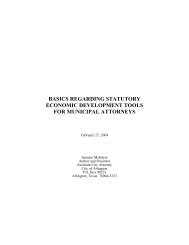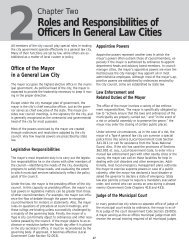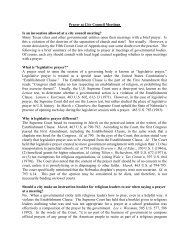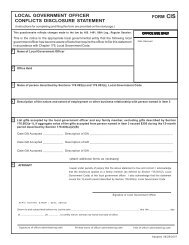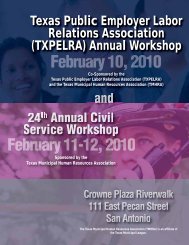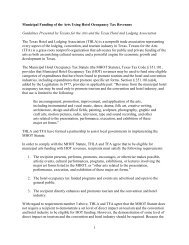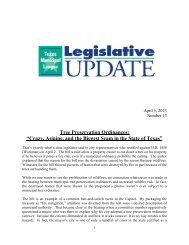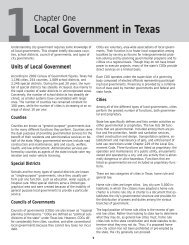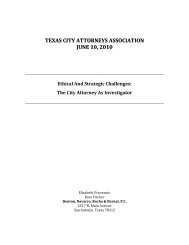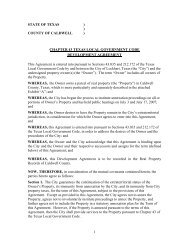Contract City Attorneys: The Employee vs. Independent Contractor ...
Contract City Attorneys: The Employee vs. Independent Contractor ...
Contract City Attorneys: The Employee vs. Independent Contractor ...
Create successful ePaper yourself
Turn your PDF publications into a flip-book with our unique Google optimized e-Paper software.
Under the category of behavioral control, the IRS looks at factors such as the instructions that aregiven to the worker by the hiring entity, as well as any training provided to the worker, andevidence of whether the recipient of the worker’s services has a right to direct or control how theworker performs the tasks for which he or she is hired. 7 In the financial control category, thefocus is on the independence of the work and includes factors such as: (1) whether the hiringentity reimburses the worker for business expenses, (2) the extent of the worker’s investment, (3)how the worker makes his or her services available to the general marketplace, (4) how thehiring entity pays the worker, and (5) the profit potential or risk of loss placed on the worker. 8<strong>The</strong> final category, the type of relationship between a worker and a hiring entity, includesevidence of written contracts, whether or not the entity provides the worker with employee-typebenefits (such as health insurance, vacation pay, or fringe benefits), the length and permanencyof the relationship, and how integrated a worker is in respect of the key aspects of the entity.A hiring entity can also be afforded relief from federal tax obligations through safe havenauthorizations set by Congress in Section 530 of the Revenue Act of 1978. 9 <strong>The</strong> IRS InternalRevenue Manual, 10 which sets out mandatory procedures for IRS examiners, states that “Section530 is a relief provision that should be considered as the first step in any case involving workerclassification … [r]elief is available to businesses that are under examination … with respect toassessments based on employment status reclassification.” Section 530 relief is based on threerequirements: (1) a reasonable basis for not treating workers as employees; (2) substantiveconsistency; and (3) reporting consistency. Under Section 530(a)(2), reasonable basis can beestablished by reasonably relying on judicial precedent, published rulings, or letter ruling to thetaxpayer. Reasonable basis can also be established if there is “a long-standing recognizedpractice of a segment of the industry in which the individual [is] engaged.” 11 Substantiveconsistency requires that the hiring entity “must have treated the workers, and any similarworkers, [all] as independent contractors.” 12 <strong>The</strong> final requirement for employment tax relief isfor the hiring entity to have consistently filed a form 1099-MISC for each worker. 13<strong>The</strong> IRS, realizing the complexity of the employee / independent contractor distinction, providesassistance in determining worker status so that surprises don’t occur during IRS audits and otherevents. Form SS-8, aptly titled “Determination of Worker Status for Purposes of FederalEmployment Taxes and Income Tax Withholding,” may be submitted to the IRS to clarifyworker status. 14 This form does not apply to “proposed transactions or hypothetical situations,”but an information letter may be issued by the IRS if it deems it necessary. 15<strong>The</strong> IRS has reportedly ramped up efforts to accurately classify worker status over the past fewyears. 16 <strong>The</strong> determination of whether a worker is an independent contractor or employee isindeed a complicated one, requiring careful planning by both the hiring municipality and theworker; however, careful planning in advance may prevent major financial and administrativeburdens in the future.1. This article does not address FICA responsibility in relation to “Section 218” agreements. Formore information, see http://www.ssa.gov/slge/sect_218_agree.htm.
2. 26 U.S.C.A . § 3401(c) (2005). See also http://www.irs.gov/pub/irs-pdf/p15a.pdf.3. 26 U.S.C.A. § 3121(d) (2005).4. 26 C.F.R. § 31.3121(d)-1 (1987).5. Id.6. See, e.g., IRS Publication 15-A (2007) at http://www.irs.gov/pub/irs-pdf/p15a.pdf.7. IRS Publication 15-A - Employer’s Supplemental Tax Guide, (2007). Specifically, theinstructions include when and where to do the work, what tools or equipment to use, whatworkers to hire or to assist with work, where to purchase supplies, what work must be performedby a specific individual, what order or sequence to follow.8. Id.9. See Section 530 of P.L. 96-600, 92 Stat. 2885 (1978) as amended by P.L. 96-167, 93 Stat.1278 (1979); P.L. 96-541, 95 Stat. 3204 (1980); P.L. 97-248, 96 Stat. 552 (1982); and P.L. 104-188, 110 Stat. 1766 (1996).10. IRS Manual, § 4.23.5 (Feb. 2003), at http://www.irs.gov/irm/part4/ch23s05.html.11. Id.12. IRS Publication 1976 (Sept. 1996) at http://www.irs.gov/pub/irs-pdf/p1976.pdf.13.Id.14. IRS Form SS-8 - Determination of Worker Status for Purposes of Federal EmploymentTaxes and Income Tax Withholding (2006) at http://www.irs.gov/pub/irs-pdf/fss8.pdf.15. Id.16. Sandra Block, No More Mr. Nice Guy - IRS Swoops in for Audits, USA TODAY (April 13,2005) at http://www.usatoday.com/money/perfi/taxes/2005-04-13-irs-gets-tough_x.htm.



